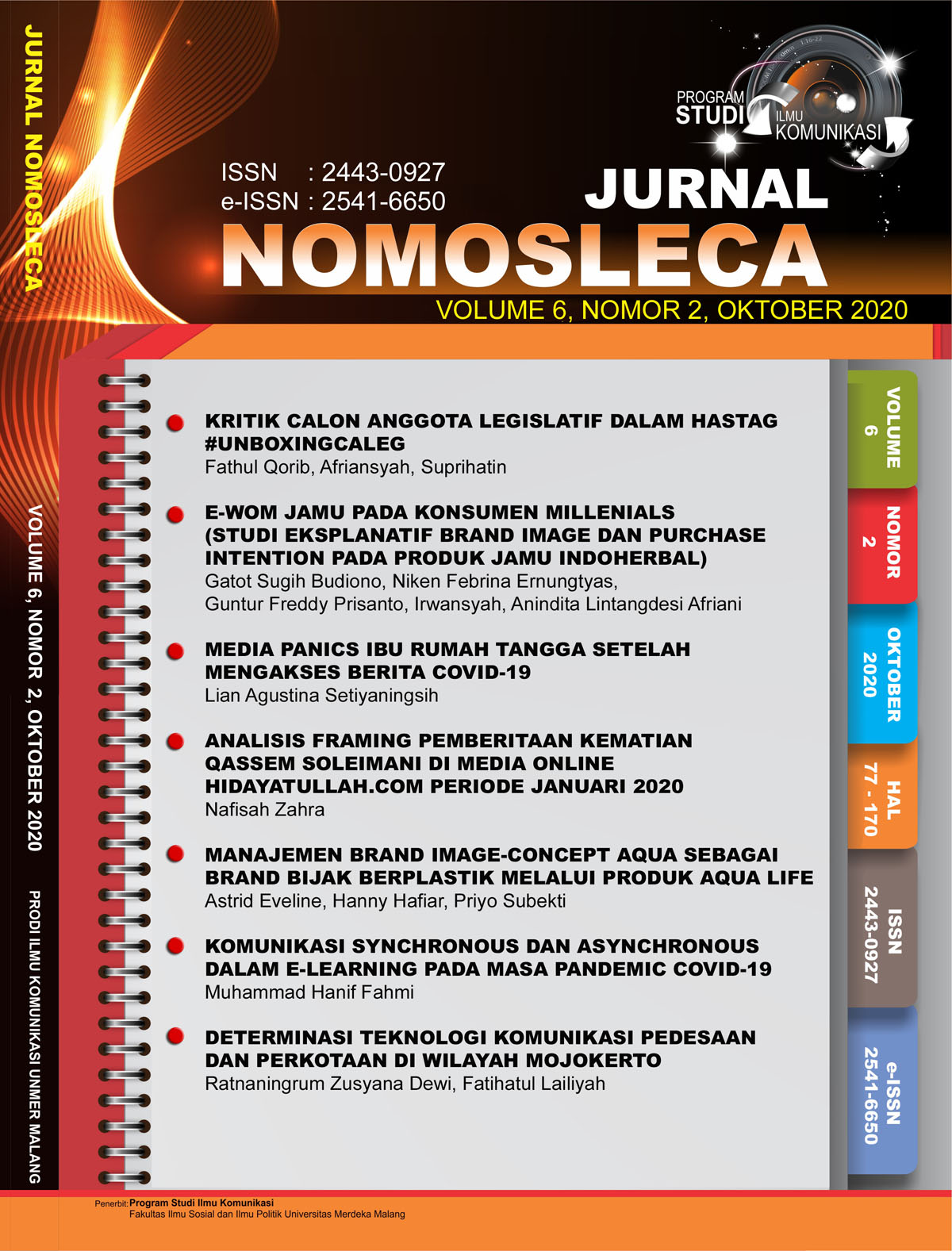Manajemen Brand Image-Concept AQUA Sebagai Brand Bijak Berplastik Melalui Produk AQUA Life
DOI:
https://doi.org/10.26905/nomosleca.v6i2.4428Abstract
This study titled "AQUA Brand Image-Concept Management as a Bijak Berplastik Brand through AQUA Life Product" is a descriptive study with qualitative data type that focuses on knowing AQUA Brand Image-Concept Management as a Bijak Berplastik Brand through AQUA Life product. This study aims to answer questions regarding; 1) step of Consumer Needs Matching, 2) step of Identify Potential Brand Image, 3) step of Identify the Brand Concept, and 4) step of Selecting Brand Image-Concept Strategy on Brand Image-Concept Management as a Bijak Berplastik Brand through AQUA Life product. Data collection techniques used included interviews with eight key informants, non-participatory observation, and literature study. Technical validity of the data using source triangulation. The results of this study revealed that; 1) AQUA has carried out ideal consumer matching needs, but can still be optimized by categorizing products, segmenting benefits, and current needs of consumers that are done more specifically, 2) AQUA is still not optimal in identifying potential brand images, where AQUA has not done the verification process data in market research, 3) AQUA is still not optimal in identifying brand concepts, namely in mapping experiential abstractions delivered to consumers through AQUA Life products, 4) AQUA is still not optimal in selecting potential brand image-concepts, that is, it has not distributed its products to all distribution channels where product availability has an influence on buying interest and attractiveness of consumers to the desired product AQUA Life can form the brand image of AQUA as a Bijak Berplastik brand.
Keywords: Brand Image Management, Brand Concept, Brand Image-Concept, Aqua Life
Downloads
References
Abimbola, & Vallaster. (2007). Brand, organisational identity and reputation in SMEs: an overview. Qualitative Market Research: An International Journal , 10(4), 341-345.
Ardianto, Elvinaro. (2011). Metodologi Penelitian untuk Public Relations Kuantitatif dan Kualitatif. Bandung: Simbiosa Rekatama Media.
Keller, Kevin Lane (2012). Strategy Brand
Management Building, Measuring, and
Managing Brand Equity, 4th Edition. New
Jersey : Prentice Hall Kotler
Moleong, Lexy. J. (2012). Metodologi Penelitian
Kualitatif. Bandung: PT Remaja Rosdakarya.
Ahmad, R. (2003). Benefit Segmentation: A potentially useful technique of segmenting and targeting older consumers. International Journal of Market Research, 45(3).
Aji, Angga. (2014). Strategi Penggunaan Media Sosial Untuk Meningkatkan Brand Image. Universitas Gadjah Mada.
Atnan. (2014). Analisis Pengaruh Persepsi Kualitas, Ketersediaan Produk, Product Knowledge Terhadap Brand Awareness Produk Private Label.
Brakus, Schmitt, & Zarantonello. (2019). Brand Experience:What Is It? How Is It Measured? Does It Affect Loyalty? American Marketing Association, 73, 52-68.
Cho, Y. (2003). The impact of product category customer dissastification in cyberspace.
Connet. (2004). Marketing and Promotional Mix. Universiteit of Petroria, 2.
Dian, Nuranindya. (2016). Proses Pembentukan Brand Awareness dan Brand Image Melalui Penerapan Integrated Marketing Communication (IMC). Universitas Indonesia.
Halim, R., & Zulkarnain, E. (2017). The Effect of Consumer Affinity and Country Image Toward Wiilingness to Buy.
Hamid, Rasool, Kiyani, & Ali. (2012). Factors Affecting the Brand Recognition; An Exploratory Study. Global Journal of Management and Business Research, 12(7), 75-78.
Hyman, & Sierra. (2015). Marketing Research Process : Six Stages.
Jain, M. (2013). An Analysis of Marketing Mix: 7Ps or More. Asian Journal of Multidisciplinary Studies, 1(4), 23-27.
Khurram, M., Qadeer, & Muhammad, S. (2018). The Role of Brand Recall, Brand Recognition and Price Consciousness in Understanding Actual Purchase.
Khurram, Qadeer, & Sheeraz. (2018). The Role of Brand Recall, Brand Recognition and Price Consciousness in Understanding Actual Purchase. Journal of Research in Social Sciences, 6(2), 219-227.
Langseng, E. (2014). A Typology of Consumption Value. Scandinavian Journal of Business Research, 28, 107-117.
Lawson, R., & Subra, B. (1998). Developing and Managing Brand Image and Brand Concept Strategies. Developing and Managing Brand Image and Brand Concept Strategies, 123.
Max, & Neef. (2017). Development and human needs .
Muliawan, & Sugiarto. (n.d.). Pengaruh Food Quality dan Ketersediaan Produk Terhadap Repurchase Intention Produk Sari Roti di Surabaya . 1-3.
Park, Jaworski, & MacInnis. (1986). Strategic Brand Concept Management.
Pratama, Agrie. (2012). Peran Social Media Dalam Membangun Brand Image Guna Mempertahankan Corporate Image. Universitas Indonesia.
Setiawan, & Fadillah. (2014). Tinjauan Atas Penetapan Harga Produk Peralatan Kesehatan Pada PT. Rivi Utama. 1-20.
Smith, S., & Albaum, G. (2012). Basic Marketing Research.
Solomon. (1963). The Role of Products as Social Stimuli: A Symbolic Interactionism Perspective. Journal of Consumer Research, 10.
Srivastava, Alpert, & Shocker. (1984). A Customer- oriented Approach for Determining Market Structure. Journal of Marketing Research Collection Lee Kong Chian School Of Business, 48(2), 35-42.
Puspita, Sondang. 2008. Efektivitas Kegiatan
Marketing Public Relations Centro
Plaza Semanggi Terhadap Customer
Satisfication. Universitas Indonesia, 11-13
Thabit, & Raewi. (2018). The Evaluation of Marketing Mix Elements:. International Journal of Social Sciences & Educational Studies, 4(4), 100-104.
Thomson, MacInnis, & Park. (2005). The Ties That Bind: Measuring the Strength of Consumers’Emotional Attachments to BrandsTHE. Jounal of Consumer Psychology, 15(1), 77-91.
Velotsou, & Suffolk. (2009). Brand Relationship Through Brand Reputation and Brand Tribalism. Journal of Business Research, 314-322.
Venessa, & Arifin. (2014). Pengaruh Citra Merek (Brand Image) dan Harga Terhadap Keputusan Pembelian Konsumen.
Wijaya. (2013). Dimensions of Brand Image: A Conceptual Review from the Perspective of Brand Communication. European Journal of Business and Management, 5(31), 55-63.
Winzar, H. (1992). Product Classification and Marketing Strategy. 262.
Downloads
Published
Issue
Section
License

This work is licensed under a Creative Commons Attribution-ShareAlike 4.0 International License.





